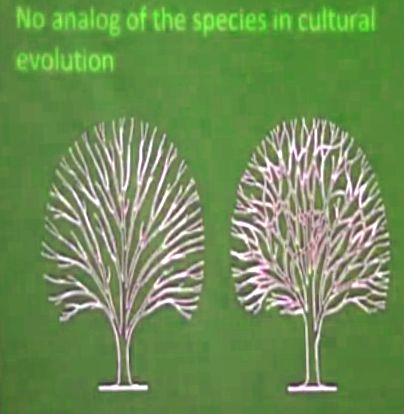 Some claim there is no such thing as a species - in the context of cultural evolution.
Some claim there is no such thing as a species - in the context of cultural evolution.For example, the image to the right is a slide from one of Robert Boyd's lectures (Rob plainly borrowed it from Krobner (1948)). He explains (38 minutes in) that the left tree is the tree of life and the right tree is the tree of culture. He says:
Famously cultural evolution doesn't have any analog to species...and...
There's no such thing, there's nothing like a species in cultural evolution and the theories that have been built of it don't have anything like a species in them.
However, there surely are cultural species. The problem with this diagram is not that the right-hand side is wrong, but that the left-hand side is wrong. To a first approximation, most organisms are bacteria, and their phylogenetic tree looks much more like the right-hand tree than the left-hand tree. A bit of information transfer doesn't destroy the idea of a species. If it did, then horizontal gene transfer by viruses would mean that there is no such thing as a species. Remember that 8% of human DNA comes from viruses.
My most common examples of cultural species are origami patterns and FORTRAN programs. These things are pretty clearly delimited - and so qualify as species. Also, let's remember that whale song has yet to be decoded. Whale memes and human memes have yet to combine to an appreciable degree.
"Species" is too useful a concept to be confined to the organic realm. The cultural realm surely has its species too.
If your conception of a species is such that it turns out that there are no cultural species, then your concept of species has turned out to not be very generally applicable - and you should reconsider the criteria that you are using.
Others in the field do use the concept of cultural species as well. Kate Distin has a large section on cultural species in her Cultural Evolution book.










No comments:
Post a Comment